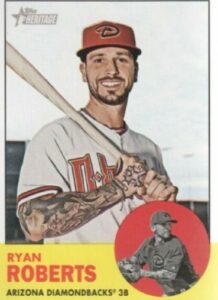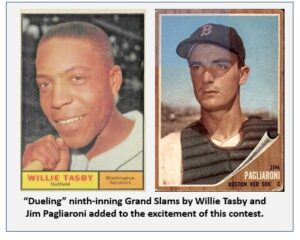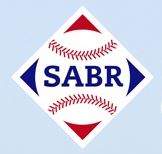Not Likely to See that Again
Right-hander Tom Glass left the mound after the eighth inning of his Athletics’ June 15, 1925 game against the Indians with his team down 15-4, but still came away with his only major -league victory.
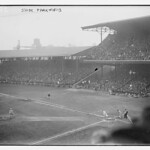
Shibe Park … Home of the Philadelphia Athletics.
Photo by The Library of Congress
Tom Glass had what can best be described as a brief major-league career. It encompassed all of two appearances with the Philadelphia Athletics in 1925. His final stat line was 1-0, 5.40, giving up nine hits and three earned runs in five major-league innings. That one victory was memorable, however, coming in what Baseball Roundtable would judge as MLB’s greatest-ever, late-inning comeback. It came on June 15, 1925, with Glass’ Athletics taking on the Cleveland Indians in Philadelphia. Glass came into the game in the top of the sixth, with the Athletics trailing 12-2. When he tossed his last pitch of the game (also his last pitch in the major leagues), he had given up three runs on seven hits over three innings – and the Athletics were facing a 15-4 deficit. And yet, Glass was about to pick up his one and only MLB victory – as the Athletics were about to put together a 13-run eighth inning comeback. In the frame:
- There were seven singles, a triple, a home run and three walks.
- Ten different players crossed the plate.
- In one stretch, ten straight batters reached base.
- The Athletics used just one pinch hitter – Sammy Hale, who hit an RBI single, stole a base ans scored a run.
- Al Simmons had two hits in the frame, a single and a three-run home run.
The inning went like this:
- With Jake Miller pitching, Athletics’ SS Chick Galloway led off with a walk.
- Pitcher Tom Glass flied out to right.
- 2B Max Bishop walked.
- 3B Jimmy Dykes hit a two-run triple to center.
- By Speece replaced Miller the mound, and LF Bill Lamar greeted him with a run-scoring single.
- CF Al Simmons singled, sending Lamar to third.
- RF Frank Welch singled, scoring Lamar and sending Simmons to third.
- C Charlie Berry (no, not Chuck Berry) singled, plating Simmons.
- Carl Yowell replaced Speece and and walked Jim Poole, loading the bases.
- Galloway got his second plate appearance of the inning and hit a two-run single.
- George Uhle replaced Yowell on the hill and PH Sammy Hale (hitting for Glass) singled home Poole, with Galloway going to third. (Hale then stole second).
- Bishop hit a two-run single in his second plate appearance of the inning.
- Dyke hit into a fielder’s choice (shortstop to second) and was replaced buy pinch runner Walt French (with the score now 15-14).
- Lamar walked.
- Simmons popped a three-run homer to give the Athletics a tw0-run lead.
- Welch flied out to right to finally end the inning.
Rube Walberg then set the Indians down, giving up a lone single, in the ninth and the Athletics had their comeback win (and Glass his major-league victory). Glass was released by the Athletics one week later and never again took the mound in a major-league game.
Notably, the Athletics came back from a 12 run-deficit (15-3) going into the bottom of the seventh (tying the MLB record for the largest run-deficit ever “recovered from.” The others to accomplish this feat? On June 18, 1911, the Tigers trailed the White Sox 13-1 going into the bottom of fifth and came back for a 16-15 win. On August 5, 2001, the Indians trailed the Mariners 14-2 after six innings and came back for a 15-14 win in 11 innings. Still, the 1925 Athletics came back from a 12-run deficit later in the game than either the Tigers or the Indians – and being behind by 11 in the eighth (and making it all up .. and then some … in one inning) just adds to their edge in the BBRT “comeback” rating. (While their backs weren’t against the wall in the eighth – they did have one more inning to bat if they needed it – they were about as close to the wall as you can get.)
Baseball Roundtable would like to dedicate the remainder of this post to truly “backs-against-the-wall” MLB comebacks. (This is just another example of BBRT’s research philosophy of “one thing least to another.”) As I approached this post, I first had to define my criteria. For me, backs-against-the-wall meant games in which the maximum deficit was in place in the ninth inning (or later). Baseball-Reference.com showed 41 games in which the ultimate winning team was down by five or more runs in the ninth inning (and either won or tied the game in that frame) – and one contest in which that five-run deficit criteria was met in the bottom of the tenth. That seemed to be too many games for a single blog post, so I narrowed the field a bit more – going for games in which the winning team was down by five or more runs, with two outs and no one on base in the ninth (or an extra) inning. I also added the stipulation that the team had to not just tie the game, but score the winning run in the comeback inning – and decided to focus on just the biggest comebacks under those circumstances (which proved to be overcoming a six-run deficit). Now, I had a workable set. Then, as I put this together, I decided to add one more game – the biggest comeback with two out in the bottom of the ninth, regardless of base runners.
___________________________________________
Biggest Comeback with Two Out and No One on Base in the Ninth Inning – Six-Run Deficit
Bottom of the Ninth … Pirates, July 28,2001 … Fifteen Pitches/Seven Runs
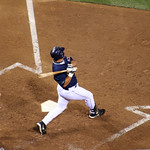
Brian Giles Grand Slam topped this comeback. Photo by ewen and donabel 
The biggest comeback with two outs and no one on in the bottom of the ninth belongs to the 2001 Pirates. On July 28 of that season, the Pirates went into the bottom of the final frame trailing the Astros 8-2. The Astros had racked up 12 hits – led by 3B Vinny Castillo’s three home runs (giving him 15 on the season). The Pirates had just seven safeties and had not gone yard.
Michael Jackson (no, not that Michael Jackson), who had come on to pitch in the eighth (and set down the Pirates 1-2-3 ) was on the mound for the Astros. He retired 3B Aramis Ramirez and a fly to left and John Vander Wal on a fly to center – five up and five down in his appearance to this point. The Pirate were down six runs – and down to their last out. Yet, just fifteen pitches later, they would be celebrating a victory.
Over the next ten pitches from Jackson:
- 1B Kevin Young doubled on the first pitch he saw.
- 2B Pat Meares homered on a 1-0 offering.
- PH Adam Hzydu singled on the first pitch he saw.
- CF Tike Redman walked on four pitches.
- SS Jack Wilson hit an 0-1 pitch for an RBI single.
After this barrage, the Astros brought in closer Billy Wagner. But Wagner, who would save 39 games that season, could not save this one. Here’s how his (five-pitch) outing went:
- C Jason Kendall was hit by a 1-1 pitch, loading the bases.
- Pirates’ clean-up hitter Brian Giles smashed a game-winning Grand Slam home run (1-0 pitch). Notably, six of the final seven Pirates’ batters were hitting .250 or under at the close of the game. (Giles was the lone exception at .326).
Top of the Ninth … Cubs, June 29, 1952 … Church Can’t Close it Out on a Sunday
On Sunday, June 29, 1952, the Cubs were facing the Reds in a doubleheader in Cincinnati. They had, appropriately, started Bubba Church on that Sunday. The Reds seemed to have the first game in hand, taking an 8-2 lead into the top of the final inning. At this point, they had collected 15 hits to the Cubs’ six. Church was on the hill for the Reds – looking for hit looking for his first win of the season. Despite the big lead, it was not to be.
Brief Break: One Rough “Comebacker” … One Gritty Comeback
Phillies’ rookie pitcher Emory “Bubba” Church – somewhat famously – bounced back from a viscous line drive to the face off the bat of slugger Ted Kluszewski. On September 15, 1950, the Phillies hosted the Reds, with Church (8-4, 2.22) getting the start (in Philadelphia). Church took a 1-0 lead into the top of the third – although he wasn’t particularly sharp, having already surrendered two walks and two hits. With two outs in the third, he walked Johnny Wryostek bringing up Kluszewski, who lined a ball up the middle – and off Church’s face. The ball was hit hard enough that it caromed off Church’s head and into right field – on the fly.
Church spent eight days in the hospital and, just one day after his release, was back on the mound for the Phillies – going five innings in a 11-0 loss to the Dodgers. He got one more start that season, but lasted only 2/3 of an inning, Still, it took one tough cookie to come back to the mound so soon after the Kluszewski smash. Note: Church came back to have his best season in 1951 (15-11, 3.53, with 15 complete games and four shutouts)
Trivia Tidbit: On May 25, 1951, Church was the first MLB pitcher to face highly touted Giants’ rookie Willie Mays – and he struck Mays out looking in the future Hall of Famer’s first MLB at bat. (Mays went 0-for-4 against Church that game.
The top of the ninth started out fine for Church, who got Cubs’ C Toby Atwell on a ground out and RF Bob Addis on a strikeout. Then, just one out away from victory, his afternoon went south – like this:
- 3B Bill Serena – double.
- SS Roy Smalley – walk.
- PH Gene Hermanski – single, scoring Serena, Smalley moving to third.
- 2B Eddie Miksis, bunting, safe on error, with Smalley scoring and Hermanski gong to second.
The Cubs now brought in Frank Smith to pitch – and he didn’t stop the bleeding. Smith faced just two batters:
- CF Hall Jeffcoat hit by a pitch, loading the bases.
- 1B Dee Fondy – two-run single.
- LF Hank Sauer – RBI double.
With the score now 8-7, the Reds brought Ken Raffensberger to the mound.
- PH Bruce Edwards was gifted an Intentional Walk, loading the bases.
- Johnny Pramesa (hitting for Addis who opened the inning) rapped a two-run single – (putting the Cubs up 9-8).
- And, finally, Bill Serena popped out to third base to end the inning.
Dutch Leonard came on for the bottom of the ninth and gave up a lone walk, while holding the Reds Scoreless.
______________________________________________
Biggest Comeback Bottom of an Extra Inning with Two Out and N0 One on Base (five-run deficit) … Dodgers, September 27, 2011
On the evening of September 27, 2011, the Dodgers faced off against the Diamondbacks (in Arizona) with Hiroki Kuroda on the mound for LA and Jarrod Parker starting for Arizona. By the top of the seventh, both starting pitchers were gone – but neither had been roughed up. In fact, after nine innings (and a dozen pitchers), the two teams were knotted at 1-1.
Then came the top of the tenth inning – and the bats seemed to wake up and leave the cave. The Diamondbacks brought in Micah Owings, their seventh pitcher of the contest. Two singles, a double, a triple, a walk, one pitching change and three outs later, the Dodgers had a 6-1 lead (and, undoubtedly, a significant number of fans were headed for the exits).
The Dodgers brought in Blake Hawksworth, their seventh pitcher, and he quickly got the first two batters on a pair of weak ground outs. However, the Dodgers were not to retire another batter.
- RF Cole Gillespie hit a ground ball single.
- Then Hawksworth got ahead of C Miguel Montero 0-2 (putting the D-backs down to their last strike – and still down five runs), but Montero hit the 0-2 offering for a groundball single through the hole between second and short – putting runners on first and third.
- Montero scampered to second (no throw) on the first pitch to CF Chris Young, who ended up walking on four pitches, loading the bases.
- John McDonald then pinch hit for Micah Owings and was safe on an error by 3B Aaron Miles.
- The Dodgers had seen enough and brought in Javy Guerra to pitch to 2B Aaron Hill, who walked to force in a run.
- Next up was 3B Ryan Roberts, who hit the first pitch he saw from Guerra for a game-winning, walk-off Grand Slam (his 19th and final round tripper of the season). So, after being down five runs, with two outs and no one on in the bottom of the tenth, the Diamondbacks had come back for a 7-6 win. On a bit of side note: The walk-off Grand Slam was the only Grand Slam of Ryan’s nine-season MLB career, during which he went .243-46-169 in 518 games.
_____________________________________________
Biggest Comeback with Two-out in the Bottom of the Ninth (no limit on base runners) … June 18, 1961 – Red Sox (down by seven)
On June 18, 1961, the Senators faced off against the Red Sox at Fenway and took a slim 7-5 lead into the top of the ninth. The Senators then put cross five runs in the top of the final inning – fueled primarily by CF Willie Tasby’s Grand Slam.
Trivia Note: Senators CF Willie Tasby (.304 average coming into the game) was the only .300 hitter (position player) to appear in the game. Senators’ reliever Marty Kutnya, who didn’t bat in the game, came in hitting .400 (four-for-ten) on the season.
That set the stage for the greatest, two-out-in-the-ninth comeback ever. With Carl Mathias pitching, Red Sox’ 1B Vic Wertz opened the inning by grounding out pitcher-to -first; SS Don Buddin followed with a single to right. Next, Bill Harrell pinch hit for pitcher Ted Wills and Mathias fanned him – putting the Red Sox down to their last out – still trailing 12-5. Now the fun begins:
- 2B Chuck Schilling singled, sending Buddin to second.
- LF Carroll Hardy drove in Buddin with a single to center.
A Brief Break from Our Story: Carroll Hardy and Ted Williams
Can anybody replace Ted Williams? Carroll Hardy gained a degree of notoriety – and a spot in the Trivia Hall of Fame – on September 20, 1960, when he became the only player ever called upon to pinch hit for Ted Williams. (Williams had fouled ball off his foot and had to leave the game). Hardy, by the way, hit into a double play. Just over a week later (September 28), when Williams was called in from left field (in order to set the stage for a standing ovation as the Splendid Splinter left his final MLB game), Hardy replaced Williams in left. Thus, also becoming the final player ever to replace Williams in the field during an MLB game.
- CF Gary Geiger walked, loading the bases.
- Dave Sisler came in to pitch and walked RF Jackie Jensen to force in a run.
- 3B Frank Malzone walked to forced in a run.
- C Jim Pagliaroni, hit a Grand Slam to deep left – tying the score.
- Wertz walked in his second plate appearance of the inning.
- Marty Kutnya replaced Sisler on the bump and gave up single to Buddin, putting runners on first an second.
- Russ Nixon pinch hit for Harrell and singled in the winning run.
How the game had changed. The 25-rum, 24-hit, contest took only two hours and 47 minutes to complete and only six pitchers took the mound.
__________________________________________________________
Primary Resources: Baseball-Reference.com; MLB.com; Society for American Baseball Research.
Interested in other “surprise endings” to ball games? Click here.
 Baseball Roundtable is on the Feedspot list of the Top 100 Baseball Blogs. To see the full list, click here.
Baseball Roundtable is on the Feedspot list of the Top 100 Baseball Blogs. To see the full list, click here.
I tweet baseball @DavidBBRT
Follow/Like Baseball Roundtable’s Facebook Page here. More baseball commentary; blog post notifications.
Member: Society for American Baseball Research (SABR); Negro Leagues Baseball Museum; The Baseball Reliquary.



